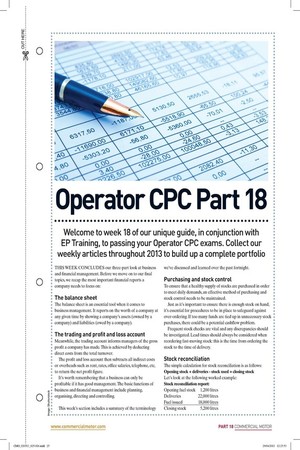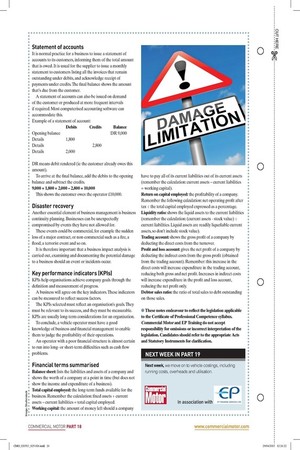Operator CPC Part 18 Welcome to week 18 of our
Page 17

Page 18

If you've noticed an error in this article please click here to report it so we can fix it.
unique guide, in conjunction with EP Training, to passing your Operator CPC exams. Collect our weekly articles throughout 2013 to build up a complete portfolio THIS WEEK CONCLUDES our three-part look at business and financial management. Before we move on to our final topics, we recap the most important financial reports a company needs to focus on: The balance sheet The balance sheet is an essential tool when it comes to business management. It reports on the worth of a company at any given time by showing a company's assets (owned by a company) and liabilities (owed by a company).
The trading and profit and loss account Meanwhile, the trading account informs managers of the gross profit a company has made. This is achieved by deducting direct costs from the total turnover.
The profit and loss account then subtracts all indirect costs or overheads such as rent, rates, office salaries, telephone, etc, to return the net profit figure.
It's worth remembering that a business can only be profitable if it has good management. The basic functions of business and financial management include planning, organising, directing and controlling. we've discussed and learned over the past fortnight.
Purchasing and stock control To ensure that a healthy supply of stocks are purchased in order to meet daily demands, an effective method of purchasing and stock control needs to be maintained.
Just as it's important to ensure there is enough stock on hand, it's essential for procedures to be in place to safeguard against over-ordering. If too many funds are tied up in unnecessary stock purchases, there could be a potential cashflow problem.
Frequent stock checks are vital and any discrepancies should be investigated. Lead times should always be considered when reordering fast-moving stock: this is the time from ordering the stock to the time of delivery.
Stock reconciliation The simple calculation for stock reconciliation is as follows: Opening stock + deliveries stock used = closing stock Let's look at the following worked example: Stock reconciliation report: Opening fuel stock 1,200 litres Deliveries 22,000 litres Fuel issued 18,000 litres Closing stock 5,200 litres Statement of accounts It is normal practice for a business to issue a statement of accounts to its customers, informing them of the total amount that is owed. It is usual for the supplier to issue a monthly statement to customers listing all the invoices that remain outstanding under debits, and acknowledge receipt of payments under credits. The final balance shows the amount that's due from the customer.
A statement of accounts can also be issued on demand of the customer or produced at more frequent intervals if required. Most computerised accounting software can accommodate this.
Example of a statement of account: Debits Credits Balance Opening balance DR 9,000 Details 1,800 Details 2,800 Details 2,000 DR means debit rendered (ie the customer already owes this amount).
To arrive at the final balance, add the debits to the opening balance and subtract the credits.
9,000 + 1,800 + 2,000 — 2,800 = 10,000 This shows the customer owes the operator £10,000.
Disaster recovery Another essential element of business management is business continuity planning. Businesses can be unexpectedly compromised by events they have not allowed for.
These events could be commercial, for example the sudden loss of a major contract, or non-commercial such as a fire, a flood, a terrorist event and so on.
It is therefore important that a business impact analysis is carried out, examining and documenting the potential damage to a business should an event or incidents occur.
Key performance indicators (KPIs) KPIs help organisations achieve company goals through the definition and measurement of progress.
A business will agree on the key indicators. These indicators can be measured to reflect success factors.
The KPIs selected must reflect an organisation's goals. They must be relevant to its success, and they must be measurable. KPIs are usually long-term considerations for an organisation.
To conclude, a vehicle operator must have a good knowledge of business and financial management to enable them to judge the profitability of their operations.
An operator with a poor financial structure is almost certain to run into longor short-term difficulties such as cash flow problems.
Financial terms summarised Balance sheet: lists the liabilities and assets of a company and shows the worth of a company at a point in time (but does not show the income and expenditure of a business).
Total capital employed: the long-term funds available for the business. Remember the calculation: fixed assets + current assets — current liabilities = total capital employed.
Working capital: the amount of money left should a company have to pay all of its current liabilities out of its current assets (remember the calculation: current assets — current liabilities = working capital).
Return on capital employed: the profitability of a company. Remember the following calculation: net operating profit after tax the total capital employed expressed as a percentage. Liquidity ratio: shows the liquid assets to the current liabilities (remember the calculation: (current assets stock value) current liabilities. Liquid assets are readily liquefiable current assets, so don't include stock value).
Trading account: shows the gross profit of a company by deducting the direct costs from the turnover.
Profit and loss account gives the net profit of a company by deducting the indirect costs from the gross profit (obtained from the trading account). Remember: this increase in the direct costs will increase expenditure in the trading account, reducing both gross and net profit. Increases in indirect costs will increase expenditure in the profit and loss account, reducing the net profit only.
Debtor sales ratio: the ratio of total sales to debt outstanding on those sales.
• These notes endeavour to reflect the legislation applicable to the Certificate of Professional Competence syllabus. Commercial Motor and EP Training do not accept responsibility for omissions or incorrect interpretation of the legislation. Candidates should refer to the appropriate Acts and Statutory Instruments for clarification.







































